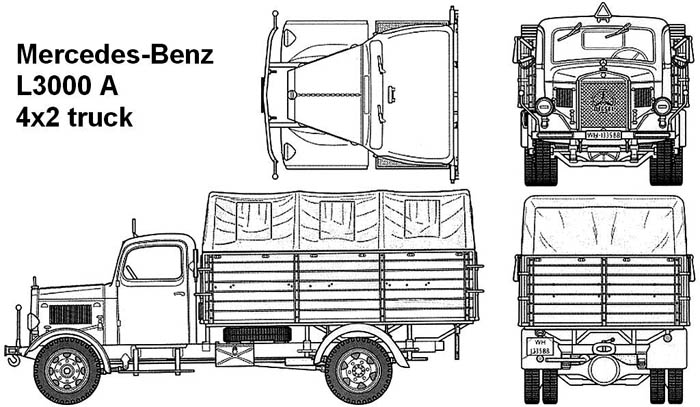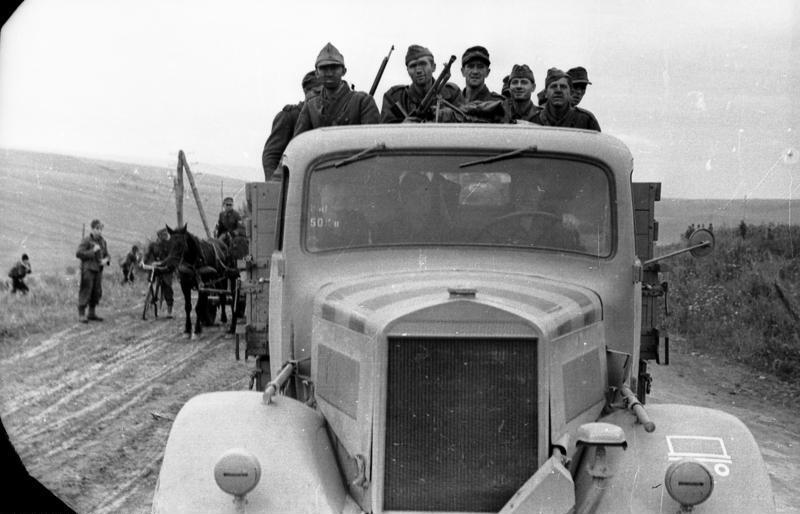Mercedes L3000
 Germany (1938-45) - Medium Truck - 33,265 built
Germany (1938-45) - Medium Truck - 33,265 built
The Mercedes-Benz L3000 was the second most common German truck after the Opel Blitz in World War II. Primarily used as a military transport this was a L3000 was a medium-duty truck with three tons payload hence the "3000". It was powered by a diesel engine and featured a robust chassis suitable for various configurations, including cargo and troop transport, as well as a flatbed for mounting artillery or anti-aircraft guns. During the war, the Mercedes-Benz L3000 played a significant role in the logistics and transportation needs of the German military, being used extensively on various fronts. After they were repurposed for civilian use, scrapped or captured as war booty by Allied forces.
Design development 1934-38

Preliminary models: From 1896 onwards, Daimler-Motoren-Gesellschaft built passenger cars, light and heavy trucks, which payload went up to 10t, proposed also to the military. The Reichswehr started to used in 1930 3-ton trucks as personnel carriers but from 1934, Daimler-Benz tested new off-road test truck under the name LG 63, and after the successs of the campaign, series production started as the Mercedes-Benz LG 3000. They were delivered to the Wehrmacht but also went to civiliabn services which needed an off-road capable truck, the Reichspost (postal service), Reichsbahn, and commercial companies, from 1936.
Production

From 1938, the 3-tonne Mercedes-Benz L 3000 truck (factory designation LGF 3000) had a modern steel cab. Unlike civilian engines running on gasoline, the L 3000 used a 4849 cm³ diesel (output of 55 kW/75 hp at 2250 rpm) for extra range. With the war starting in September 1939, civilian L 3000s started to be requisitioned as part of the material mobilization supplement, sent to the Wehrmacht. The waffenamt, transportation branch had it certificated as a "medium-sized, off-road open truck (o)", but on time, the chassos was given different bodies and equipment sets for various misssiones (see variants).
However for the sake of rationalization, German truck manufacturers from January 1, 1940 had to concentrate producing standard trucks and not their whole prewar range. Each manufacturer was given a specific type, and the L3000 was then classed as one of these "standard trucks" delivered under the name Mercedes-Benz L 3000S (S=standard) and L 3000A (A=all-wheel drive). The number corresponded to the weight, light, three tonnes or 3,000 kgs.
Production of the L 3000 stopped in 1944 since they were only turned by the Opel factory in Brandenburg, whih was completedly flattened after an allied air raid in early August 1944 while Daimler-Benz became sole manufacturer of the Opel "Blitz" 3.6, the most well regarded and common standard German truck in the war. Licensed production at Daimler-Benz's Mannheim truck plant just started at that point. Apart the L 3000 and 3-ton Opel "Blitz", Daimler-Benz manufactured other types also used by the Wehrmacht.
Notably appeared the Mercedes-Benz L 4500 S/A, a wartime 4.5 t truck, with many converted as "Maultier" using half-tracks from Panzer II chassis.
On the other side of the spectrum was the lighter Mercedes-Benz L 1100, L 1500 S/A and L 2000 L (in which L meant Licht or "light"). For the sake of standardization and unlike previous models, they all used the same rounded, simple to make fenders. From 1943, civilian trucks used a wood gasification system to free petrol fuel for the Wehrmacht exclusive use. Also as steel started to be lacking, many received a simplet flat sides wooden driver's cab.
Design
 4 views, unknown origin, via pinterest
4 views, unknown origin, via pinterest
The L 3000 had two-axle with rear twin roadwheels, and the classic Mercedes U-profile ladder frame, whereas both rigid axles are suspended on half springs both forward and at the rear. The front axle has single tires, rear double tires as seen above, and all had the same size, 7.50-20 plus with off-road tread. The braking system is hydraulically operated, acting on all wheels whereas the handbrake only applies on the rear wheels.
The engine is a Daimler 55 horsepower Mercedes-Benz OM 65/4. This was a four-cylinder, in-line, with pre-chamber burning diesel. It was fitted with OHV valve control and also water cooling. Bore and stroke measured 105 × 140 mm, with a displacement of 4849 cm³ and a Compression ratio of 20:1. It had a rated power 55 kW (75 HP) at 2250 rpm, with a torque at nominal output, of 234 Nm at 2250 rpm. The crankshaft used five bearings, driving the camshaft below, via spur gears. The fuel was injected into pre-chambers by an injection pump from Lid or Bosch depending on the series.
This engine was coupled with a ZF 700 transmission, single-plate dry clutch, manual five-speed gearbox with countershaft. The L 3000 A was different as its off-road caracteristics saw the transmission power sent both to the front and rear wheels via three limited-slip differentials. The front-wheel drive could also be switched off, whereas the off-road gear can be switched on, without the front-wheel drive switched on.
The wheelbase was 3800 mm with a front track of 1633 mm, rear track width of 1650 mm and Ground clearance of 225 mm. The L3000 on average was capable of 70 kph on road, its turning circle diameter was 15.2 m. Its Curb weight was 4020 kg with a max Payload of 3020kg (2600kg) hence its name, and Maximal permissible total mass of 7040 kg (6620 kg).
It could ford 70 cm of water, climb a 30% slope unladen. As for its range, it had a tank capacity of 90 liters of diesel fuel and a fuel consumption of 20 for 100 km or 30 liter for 100 km off-road, meaning 450-500 km on roads, and 200 off-road. Electric power was ensured by two Bosch Batteries of 12 V, each or 90 Ah.
mercedes L3000x specifications |
| Dimensions | 6255 x 2350 x 2600mm wb 3800 mm |
| Total weight | 4020 kg, up to 7040 kg (6620 kg) |
| Crew | 1 driver, 12 soldiers |
| Propulsion | OM 65/4 inline 4-cyl. wc pre-chamber diesel engine |
| Top speed | 70 km/h |
| Payload | 3020kg (2600kg) |
| Transmission | ZF single plate dry clutch, 5+1 GB front or all axles steering |
| Suspension | Leaf springs, 2x4 |
| Max range | 500 km, see notes |
| Production | 33,265 all types combined |
Variants
- L 3000 (1938–1939) 12.840 manufactured
- L 3000 S (1939–1944) 18.356 manufactured
- L 3000 A (1940–1942) 2.069 manufactured
During the late 1930s and early 1940s, the Mercedes L 3000 was the most successful truck in its class. He was completely convincing in both peaceful and military operations. Its powerful and economical diesel engine with the designation OM 65 performs for that time a Relatively high 75 hp engine output at 2,250 rpm from a displacement of 4,850 cc. At that time, competing products often still ran on gasoline-powered engines.
In 1938, the old wooden cabin was replaced by a modern and elegant all-steel cabin, like our L 3000. The vehicle, built in 1941, contains a 5-speed gearbox that shifts very easily and is available as a rare extra. The truck is in a particularly beautiful and untouched condition for its age. It starts very well and can be moved quickly. The vehicle had been owned by one owner for 70 years and was regularly serviced there. The late production L3000S were simplified: They had no rear mudguards, the front mudguards had a simplified shape, the bumper was replaced by a narrower model. Later in 1944, smaller headlights were installed. Some were also fitted with the Sonderausrüstung Winterbetrieb, a special equipment for winter operations.
The mercedes L3000 in combat
 L3000 in Hungary
L3000 in Hungary
Given its large numbers, the L3000 became soon the second most current truck of the Wehrmacht when WW2 broke out. It was OK thanks to the good road network in the early part of the Campaign from September 1939 in poland, to France and the low countries in May 1940 and again good enough for a degraded network of Greece and the Balkans. The Mercedes-Benz type L 3000 S also came with a utility cab behind and was converted for example to a field kitchen truck.
 The vehicle in Greece with Hermann Goering Paratroopers division, LKW Kastenaufbau
The vehicle in Greece with Hermann Goering Paratroopers division, LKW Kastenaufbau
However as soon as the winter 1941 arrived, the extreme cold started to play its trick on the engines. When the "rasputitsa" commenced, the Mercedes L3000S was found unable to cope with the muddy roads on the eastern front, the rival Opel Blitz was found much more efficient in these conditions. In fact only the latter gained approval for further production and cobversion into "mules" Maultier, not the Mercedes L3000A which production was stopped in 1944.
 L3000 in Hungary, 1944
L3000 in Hungary, 1944
The remaining production vehicles were thus directed to the West instead, and found action in Italy, France, the Netherlands from D-Day to the last combats in Germany in May 1945. It was at ease on the roads, and off-roads when conditions were acceptable. Unlike the Blitz, these trucks also went to specialized units, notably to the Luftwaffe, which moslty operated in more suitable environment far from the frontline. Many of these Mercedes-Benz L 3000S received a standard box body, and the latter were the most requested by Luftwaffe units. They were used as utility vehicles for all sorts of tasks (workshops, command vehicles, field kitchens, mobile generators, engine starter vehicles, searchlight carriers or even mobile FLAK carriers), useful in rear lines improvized airfields.
 In Italy 1944-45, they became the default trucks for Fallschirmjäger (paratroopers) as well.
In Italy 1944-45, they became the default trucks for Fallschirmjäger (paratroopers) as well.
The vehicle also appeared in pop culture, with a replica based on a GMC CCKW in the 1981 film Raiders Of The Lost Ark's famous chase scene. A modified Lo 2000 or L3000 carrying SS Einsatzkommandos appears on a village arrival scene in the 1983 British Horror film 'The Keep' in Romania, 1941 as well.
Sources about the mercedes L3000
Werner Oswald: Kraftfahrzeuge und Panzer der Reichswehr, Wehrmacht und Bundeswehr. Motorbuch Verlag, Stuttgart 1982.
Frank, Reinhard: Mercedes im Kriege – Personenwagen, Lastkraftwagen, Sonderaufbauten. PODZUN-PALLAS-VERLAG Dornheim. 1985.
kfzderwehrmacht.de daimler-benz AG
armedconflicts.com
veteranenhalle.de
wehrmacht-technik.de
kfzderwehrmacht.de
fahrzeuge-der-wehrmacht.de
de.wikipedia.org
ww2-weapons.com/
Mercedes-Benz trucks 1941-1945
Mercedes-Benz L3000a on o5m6.de
muzeumgryf.pl
ipmsdeutschland.de
betexa.cz
Scalemates.com
panzerserra.blogspot.com
world-in-scale.de
mercedes-benz-publicarchive.com
o5m6.de/
Schwere Geländegängiger Lastkraftwagen 4.5t Mercedes-Benz L4500A als Flakwagen